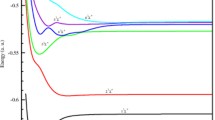Abstract:
This paper proposes a general method to investigate Feshbach resonances in atomic collisions similar to Cs(6 s ) + Cs(6 p ) in the thermal or cold regime. In order to compute the predissociation widths of the C 1 Π u (6 s + 5 d ) bound vibrational levels of Cs2, coupled both with the (2) 3 Σ + u (6 s + 6 p ) continuum and with the (2) 3 Π u (6 s + 5 d ) vibrational series, a Fourier grid method is implemented, with an optical potential. A convenient way of optimizing the latter is proposed. A large number of resonances are found and calculations of their cross-sections for stabilization into ground state molecules show that the rate may be important. This confirms the interpretation of Lintz and Bouchiat [Phys. Rev. Lett. 80, 2570 (1998)] who observed dimer formation in cell experiments. Possible generalization to the cold regime relies on the possibility to tune the position of a resonance to coincide with the maximum of the collisional energy distribution.
Similar content being viewed by others
Author information
Authors and Affiliations
Additional information
Received 14 February 2002 Published online 28 June 2002
Rights and permissions
About this article
Cite this article
Pellegrini, P., Dulieu, O. & Masnou-Seeuws, F. Formation of Cs molecules via Feshbach resonances stabilized by spontaneous emission: theoretical treatment with the Fourier grid method. Eur. Phys. J. D 20, 77–86 (2002). https://doi.org/10.1140/epjd/e2002-00120-5
Issue Date:
DOI: https://doi.org/10.1140/epjd/e2002-00120-5




